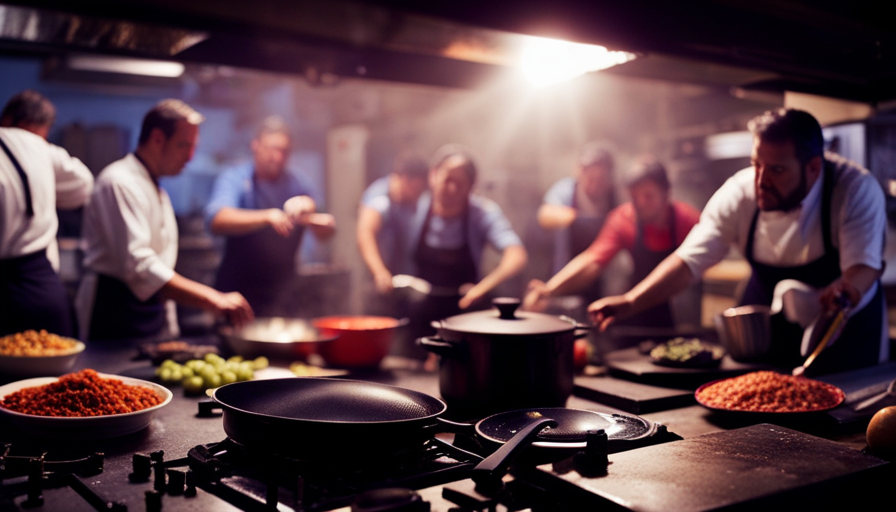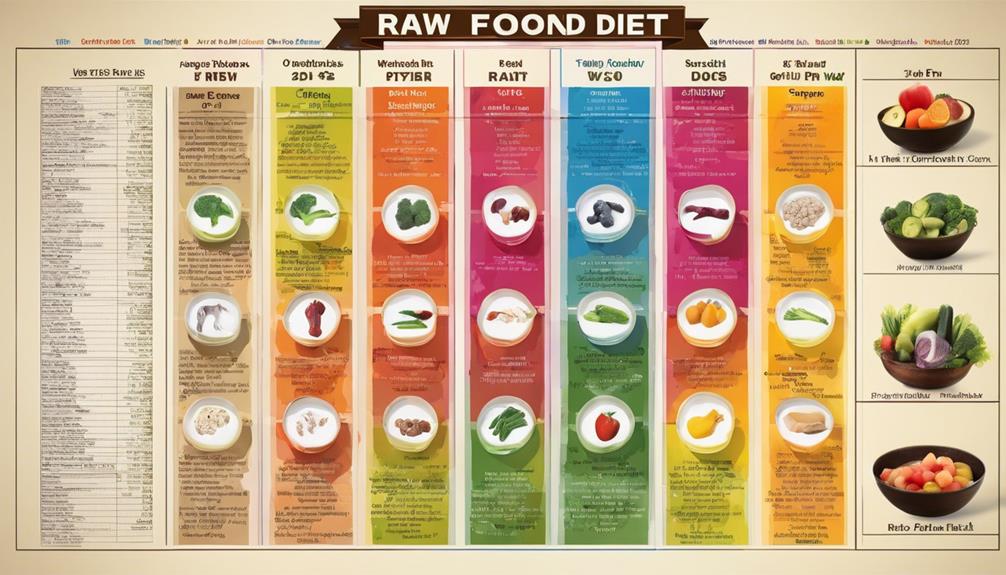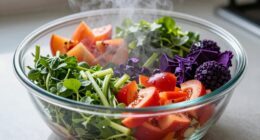As someone who loves food, I have always been fascinated by the newest culinary trends. From farm-to-table dining to molecular gastronomy, the world of food constantly keeps me on my toes.
However, one trend that has left me scratching my head is the growing popularity of raw and undercooked food. While I can appreciate the desire for freshness and the artistry behind showcasing natural flavors, I can’t help but wonder about the challenges this fad has brought forth.
Ironically, the raw and undercooked food movement, which aims to celebrate the purity of ingredients and preserve their natural qualities, has led to a plethora of challenges. From an increased risk of foodborne illnesses to the delicate balance between food safety and culinary creativity, chefs and restaurateurs are facing a whole new set of obstacles.
Moreover, adapting traditional cooking techniques, maintaining flavor and texture, addressing concerns about nutritional deficiencies, and ensuring proper handling and storage of raw ingredients have become paramount in this era of raw and undercooked food.
In this article, we will delve into the challenges posed by this fad and explore the future of the raw and undercooked food movement. So, fasten your seatbelts and join me on this culinary adventure as we explore the flip side of this seemingly appetizing trend.
Key Takeaways
- Increased risk of foodborne illnesses associated with consuming raw or undercooked foods
- Restaurants must implement strict food safety protocols to minimize the risk of illnesses
- Challenges in maintaining texture and flavor in undercooked dishes
- Risks of consuming raw food: increased risk of foodborne illnesses, potential nutrient deficiencies, allergenic reactions
Increased Risk of Foodborne Illnesses
You might find yourself experiencing a bout of severe stomach cramps and uncontrollable vomiting after indulging in that raw and undercooked meal, as the increased risk of foodborne illnesses leaves you bedridden and regretting your decision. The raw and undercooked food fad has given rise to numerous challenges, particularly in terms of public health.
Despite educational campaigns and warnings from health authorities, many people are still unaware of the potential dangers associated with consuming raw or undercooked foods. One of the primary concerns is the increased risk of foodborne outbreaks. Raw and undercooked foods, such as sushi, tartare, and rare meats, can harbor harmful bacteria like Salmonella, E. coli, and Campylobacter. These pathogens are commonly found in raw animal products and can cause serious illnesses if not properly cooked.
According to the Centers for Disease Control and Prevention (CDC), there has been a significant increase in foodborne outbreaks linked to raw and undercooked foods in recent years. To meet customer demands for raw and undercooked dishes, restaurants and food establishments must find a balance between offering trendy menu items and ensuring customer safety. This requires implementing strict food safety protocols, including proper handling, storage, and cooking techniques. By doing so, they can minimize the risk of foodborne illnesses and provide customers with a safe dining experience.
Meeting Customer Demands for Raw and Undercooked Dishes
Amidst the growing demand for raw and undercooked dishes, meeting customer expectations becomes a delicate balancing act for restaurants. Adapting menu options and sourcing fresh ingredients are key factors in satisfying this demand.
To cater to customers who prefer their dishes raw or undercooked, restaurants have had to adjust their menus accordingly. They now offer a wide range of options, from sushi and sashimi to steak tartare and crudo. This allows customers to enjoy the unique flavors and textures that come with raw and undercooked dishes.
In order to meet the demand for fresh ingredients, restaurants have had to establish strong relationships with local suppliers. This ensures that they have access to the highest quality produce and seafood. By sourcing fresh ingredients, restaurants can guarantee the safety and taste of their raw and undercooked dishes.
Adapting menu options and sourcing fresh ingredients are essential for restaurants looking to keep up with the raw and undercooked food fad. However, it is important to strike a balance between meeting customer demands and ensuring food safety. This will be further explored in the next section, which discusses the challenges of balancing food safety and culinary creativity.
Balancing Food Safety and Culinary Creativity
To keep up with the demand for raw and undercooked dishes, it’s crucial for restaurants to strike a delicate balance between culinary creativity and ensuring the safety of their food. While customers seek out these dishes for their unique flavors and textures, it’s important for restaurants to prioritize food safety measures to prevent the risk of foodborne illnesses.
In order to achieve this balance, restaurants must implement strict protocols for sourcing and handling raw ingredients. This includes ensuring that all suppliers follow proper food safety practices and conducting regular inspections to guarantee the freshness and quality of the ingredients. Additionally, chefs and kitchen staff must be trained on proper food handling techniques, such as temperature control and cross-contamination prevention, to minimize the risk of foodborne pathogens.
To better illustrate the challenges faced in balancing food safety and culinary creativity, consider the following table:
| Food Safety Challenges | Culinary Creativity Challenges |
|---|---|
| Ensuring proper storage and handling of raw ingredients | Maintaining the desired texture and flavor in undercooked dishes |
| Preventing cross-contamination in the kitchen | Finding innovative ways to cook without compromising safety |
| Implementing temperature control measures | Adapting traditional cooking techniques to raw food trend |
| Educating staff on food safety protocols | Incorporating unique and safe ingredients into dishes |
While the raw and undercooked food fad presents exciting opportunities for culinary creativity, it also poses significant challenges in terms of food safety. By implementing stringent protocols and training, restaurants can meet customer demands while ensuring the safety of their food. Transitioning into the subsequent section, it is important to explore how chefs are adapting traditional cooking techniques to the raw food trend.
Adapting Traditional Cooking Techniques to the Raw Food Trend
Imagine exploring the world of culinary creativity as traditional cooking techniques are adapted to embrace the raw food trend. Adapting traditional techniques to raw food alternatives has become a challenge for chefs seeking to create innovative and delicious dishes that are both safe and satisfying.
To address this challenge, chefs have developed various methods to maintain flavor and texture in raw and undercooked dishes.
-
Fermentation: Fermented foods have been a staple in many cultures for centuries. Chefs are now using fermentation techniques to add depth and complexity to raw food dishes. Fermented vegetables, such as sauerkraut and kimchi, provide a tangy and flavorful element to salads and wraps.
-
Dehydration: Dehydrating fruits, vegetables, and even meats can enhance their flavors and create interesting textures. It allows for the preservation of raw ingredients while intensifying their taste. Dehydrated mushrooms, for example, can add a rich umami flavor to a raw pasta dish.
-
Sous vide: Sous vide is a cooking technique that involves vacuum-sealing food in a bag and cooking it in a water bath at a precise temperature. Chefs are using this method to achieve tender and juicy results with raw or undercooked ingredients. Sous vide eggs, for instance, provide a creamy texture and a delicate flavor.
-
Smoking: Smoking is a traditional cooking technique that can be adapted to raw food alternatives. Chefs are incorporating smoked ingredients, like smoked paprika or smoked salt, to add a smoky and robust flavor to raw dishes.
As we explore the ways in which traditional techniques are adapted to the raw food trend, it’s important to consider how these methods can help maintain flavor and texture in raw and undercooked dishes while ensuring food safety.
Maintaining Flavor and Texture in Raw and Undercooked Dishes
Explore the tantalizing ways you can savor the delectable flavors and textures of raw and undercooked dishes. Maintaining the presentation and texture of raw and undercooked dishes can be a challenge, but with the right techniques and equipment, it is possible to create visually appealing and satisfying meals.
To maintain presentation, it is important to carefully select and handle ingredients. Fresh, high-quality produce is key to achieving vibrant colors and flavors. Additionally, proper knife skills are essential for slicing ingredients thinly and uniformly, ensuring a visually pleasing dish.
When it comes to texture, different methods can be employed to create a variety of textures in raw and undercooked dishes. For example, marinating vegetables or fruits in citrus juice or vinegar can help to soften their texture, while still retaining their freshness. Similarly, using a mandoline or spiralizer can create interesting textures in vegetables, adding a crunch or bite to the dish.
Handling equipment also plays a crucial role in maintaining flavor and texture. Using sharp knives, high-quality blenders, and food processors can help to ensure ingredients are properly processed and blended, resulting in smooth and well-incorporated flavors.
Maintaining the presentation and texture of raw and undercooked dishes requires careful ingredient selection, proper handling techniques, and the use of high-quality equipment. By mastering these aspects, one can create visually appealing and delicious meals that showcase the true beauty of raw and undercooked cuisine. Transitioning to the next section, educating consumers about the risks and benefits of raw food, is an important step in ensuring safe and enjoyable dining experiences.
Educating Consumers about the Risks and Benefits of Raw Food
Transitioning from the previous subtopic of maintaining flavor and texture in raw and undercooked dishes, it’s important to shift our focus to educating consumers about the risks and benefits of raw food.
As a culinary enthusiast, I’ve always been intrigued by the idea of incorporating raw ingredients into my meals. However, I quickly realized that there are potential dangers associated with consuming raw food.
To help you better understand the risks and benefits, here’s a list of key points to consider:
-
Risks of Raw Food:
- Increased risk of foodborne illnesses, such as salmonella and E. coli, due to the presence of harmful bacteria.
- Potential nutrient deficiencies, as certain vitamins and minerals are more easily absorbed when food is cooked.
- Allergenic reactions, as raw food can contain allergens that are neutralized through cooking.
-
Benefits of Raw Food:
- High nutrient content, as cooking can sometimes lead to nutrient loss.
- Improved digestion, as raw food is rich in enzymes that aid in the digestion process.
- Enhanced flavor and texture, as the natural essence of ingredients is preserved.
Understanding the risks and benefits of raw food is crucial in making informed decisions about our diet. However, it’s also important to address concerns about nutritional deficiencies in raw diets, which will be discussed in the subsequent section.
Addressing Concerns about Nutritional Deficiencies in Raw Diets
To adequately address concerns about potential nutritional deficiencies in raw diets, it is important to examine the impact of cooking on nutrient availability. Cooking can indeed alter the nutrient content of food, but it can also enhance nutrient absorption and destroy harmful bacteria. While raw food enthusiasts argue that cooking destroys enzymes and reduces the bioavailability of certain vitamins, research suggests that the overall impact of cooking on nutrient availability is not significant enough to cause deficiencies in a well-balanced diet.
To illustrate this point, let’s take a look at the table below:
| Nutrient | Raw Food | Cooked Food |
|---|---|---|
| Vitamin C | Decreased | Decreased |
| Vitamin B12 | Absent | Present |
| Calcium | Decreased | Absent |
| Iron | Decreased | Absent |
As we can see, cooking can indeed lead to some decrease in nutrient content, but it also eliminates harmful bacteria and increases the bioavailability of nutrients like Vitamin B12. Therefore, addressing nutritional concerns in raw diets is not just about avoiding deficiencies, but also promoting balanced diets that include a variety of raw and cooked foods.
In the subsequent section about ensuring proper handling and storage of raw ingredients, we will explore the importance of food safety practices in the raw and undercooked food fad.
Ensuring Proper Handling and Storage of Raw Ingredients
Addressing concerns about nutritional deficiencies in raw diets is crucial, but it’s equally important to ensure the proper handling and storage of raw ingredients. This is because the raw and undercooked food fad can pose significant risks if not done correctly.
To mitigate these risks, it’s essential to maintain proper temperatures during the handling and storage process.
One of the key challenges in handling raw ingredients is ensuring that they are kept at the appropriate temperature. This includes refrigerating perishable items promptly and storing them at temperatures below 40°F (4°C) to prevent bacterial growth. Similarly, frozen ingredients should be stored at or below 0°F (-18°C) to maintain their quality and safety.
Cross-contamination is another critical concern when handling raw ingredients. It’s essential to prevent the transfer of harmful bacteria from raw foods to ready-to-eat items. This can be achieved by using separate cutting boards, knives, and utensils for raw and cooked foods. Additionally, washing hands thoroughly before and after handling raw ingredients can help minimize the risk of cross-contamination.
To ensure food safety, it’s crucial to follow proper handling and storage practices when dealing with raw ingredients. By maintaining proper temperatures and preventing cross-contamination, the risks associated with the raw and undercooked food fad can be significantly reduced.
Now, let’s delve into the regulatory challenges and food safety standards that need to be addressed in relation to this fad.
Regulatory Challenges and Food Safety Standards
Make sure you navigate the maze of regulations and food safety standards like a skilled tightrope walker, ensuring the safety and quality of your culinary creations. Regulatory compliance and adherence to industry standards are essential when it comes to handling and serving raw and undercooked food.
The raw and undercooked food fad has presented numerous challenges for both chefs and regulators. One of the main issues is the risk of foodborne illnesses associated with consuming raw ingredients. To address this concern, regulatory agencies have implemented strict guidelines on the handling, storage, and preparation of these foods. These regulations aim to minimize the chances of contamination and ensure the safety of consumers.
For chefs and restaurant owners, complying with these regulations can be daunting. They must invest in equipment and processes that meet the required standards, such as temperature-controlled storage areas and proper sanitation procedures. Additionally, staff members need to be trained in food safety practices to prevent cross-contamination and maintain compliance.
The implementation of these regulations has also led to increased scrutiny from regulatory agencies. Inspections and audits are conducted to ensure that establishments are following the guidelines. Non-compliance can result in fines, closure of businesses, and damage to reputation.
As the raw and undercooked food movement continues to evolve, it is crucial for chefs and regulators to stay updated on the latest industry standards and adapt their practices accordingly. This ongoing commitment to safety will help shape the future of this culinary trend and ensure that consumers can enjoy raw and undercooked dishes without compromising their health.
Transitioning into the subsequent section about ‘the future of the raw and undercooked food movement’, it is important to consider the potential advancements and challenges that lie ahead.
The Future of the Raw and Undercooked Food Movement
Get ready to embark on an exciting culinary journey as you explore the future of the raw and undercooked food movement and discover the innovative possibilities that await you.
The raw and undercooked food movement has gained significant popularity in recent years, and it shows no signs of slowing down. As people become more health-conscious, they are embracing this trend for its potential health benefits.
One of the future trends we can expect to see in the raw and undercooked food movement is the incorporation of new and unique ingredients. Chefs and food enthusiasts are constantly exploring different flavors and textures to create exciting dishes. From exotic fruits and vegetables to unconventional proteins, the possibilities are endless. This not only adds variety to our diets but also introduces us to new sources of nutrients and antioxidants.
Another trend that we can anticipate is the development of innovative cooking techniques. As technology advances, so does our ability to prepare raw and undercooked food in safe and delicious ways. From sous vide cooking to high-tech blenders and food processors, these tools enable us to create culinary masterpieces that retain the natural flavors and nutritional value of the ingredients.
The future of the raw and undercooked food movement is filled with exciting possibilities. With the incorporation of new ingredients and innovative cooking techniques, we can expect to see a continued growth in this trend. So, why not embrace this culinary adventure and reap the health benefits that come with it?
Frequently Asked Questions
How can restaurants ensure proper handling and storage of raw ingredients to prevent foodborne illnesses?
To ensure proper handling and storage of raw ingredients and prevent foodborne illnesses, restaurants should follow strict protocols. First, staff should receive thorough training on food safety and hygiene practices. This includes proper handwashing, using separate cutting boards for raw and cooked foods, and regularly sanitizing surfaces and utensils.
Furthermore, raw ingredients should be stored at the correct temperatures to prevent bacterial growth. Regular inspections and audits can help identify any areas of improvement. By implementing these measures, restaurants can maintain a safe and healthy environment for their customers.
What are the main concerns regarding nutritional deficiencies in raw diets, and how can they be addressed?
Addressing nutritional deficiencies in raw diets is crucial for promoting balanced diets. One concern is the lack of nutrients that are destroyed or diminished during cooking. However, incorporating a variety of raw fruits, vegetables, and nuts can help ensure a wide range of nutrients.
Additionally, including fermented foods like sauerkraut or tempeh can enhance gut health and nutrient absorption. It’s important to consult a healthcare professional or nutritionist to tailor a raw diet that meets individual nutritional needs.
What are the regulatory challenges faced by the raw and undercooked food movement, and how do they impact food safety standards?
Regulatory challenges faced by the raw and undercooked food movement have significant impacts on food safety standards. These challenges arise due to the increased risk of foodborne illnesses associated with consuming raw or undercooked foods.
To ensure food safety, regulatory agencies need to establish strict guidelines and regulations for the handling, preparation, and labeling of these foods. By implementing these measures, they can help mitigate the potential risks and maintain high food safety standards for consumers.
What are some traditional cooking techniques that have been adapted to the raw food trend?
What traditional cooking techniques have been adapted to the raw food trend? Many traditional cooking techniques have been creatively adapted to accommodate the raw food movement.
For example, instead of using heat to cook, raw food enthusiasts may use dehydration, fermentation, sprouting, or marinating to enhance flavors and textures. These adaptation techniques allow for the preservation of nutrients while still providing a diverse and satisfying culinary experience.
How can restaurants educate consumers about the risks and benefits of raw food to make informed choices?
Restaurants can educate consumers by providing clear and accurate information about the risks and benefits of raw food. They can offer detailed descriptions of their raw food dishes and highlight any potential health concerns, such as the risk of foodborne illnesses.
Additionally, restaurants can train their staff to answer questions and provide recommendations based on individual preferences and dietary restrictions. By doing so, consumers can make informed choices about whether to consume raw food, minimizing potential risks.
How Has the Premix Trend Contributed to the Challenges of the Raw and Undercooked Food Fad?
The raw food premix meaning has added complexity to the challenges of the raw and undercooked food fad. As more people seek convenient ways to incorporate raw ingredients into their diets, the premix trend has raised concerns about potential food safety risks and nutritional imbalances.
Conclusion
In conclusion, the raw and undercooked food fad has presented both opportunities and challenges for the culinary industry. While it has allowed for innovative and creative dishes, it has also increased the risk of foodborne illnesses and raised concerns about nutritional deficiencies.
Chefs and restaurants must find a balance between meeting customer demands and ensuring food safety. Additionally, adapting traditional cooking techniques to the raw food trend and properly handling and storing raw ingredients are crucial.
As we move forward, it is essential to address regulatory challenges and establish food safety standards to ensure the future success of this movement. So let’s grab our forks, dive into this trend, and stay ahead of the curve!










